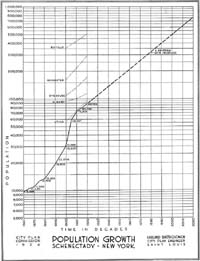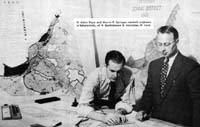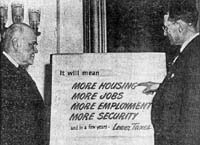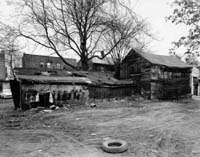[This information is from pp. 51-61 of Shovel Ready: Razing Hopes, History, and a Sense of Place: Rethinking Schenectady's Downtown Strategies, a master's thesis in city planning by Christopher Patrick Spencer (MIT, 2001), and is reproduced with his permission. It is in the Schenectady Collection of the Schenectady County Public Library at Schdy R 711 Spe.]
Make no little plans; they have no magic to stir men's blood and probably will not be realized. Make big plans; aim high in hope and work, remembering that a nobler, logical diagram once recorded will never die, but long after we are gone will be a living thing, asserting itself with evergrowing insistency. Remember that our sons and grandsons are going to do things that would stagger us.
Let your watchword be order and your beacon beauty.
Daniel H. Burnham
When the Plan of Chicago, also known as "the Burnham Plan" was published in 1909, it not only set the stage for future development of Chicago, but "…established a pattern for American city planning." (1) Cities everywhere were experiencing extraordinary growth and beginning to realize that continued haphazard expansion would only impede their future success. The plans were often not as concerned with fixing the past as they were with building a new future. Indeed some felt, "It may or may not be possible to effect changes in the old city to make it more healthful and more efficient, but there can be no argument against planning a better city to cover the outlying areas that are now open fields." (2)
In 1947, Schenectady adopted a new plan, which involved not only future expansion but considered the redevelopment of large areas of the existing city along the edge of its Central Business District. During the next 20 years or more, with the help of federal and state programs, the city would drastically change the form of that area and its relationship to the rest of the downtown and the other residential neighborhoods that bordered it.
Schenectady's recognition of its growth and the need for planning started in 1912, when a group of citizens led by Charles P. Steinmetz, one of the city's most famous citizens, "engaged Dr. John Nolen of Cambridge, Massachusetts to prepare a plan for city improvement and extension." Although the report was never published or circulated, Planning a City for the People helped to improve the city's park system and sparked a "genuine interest on the part of the city in its own future welfare." (3) In 1923, with the city still in the midst of its most explosive growth period, Schenectady engaged one of the most prolific city planning firms of the time, Harland Bartholomew and Associates, to prepare a plan for the city's future. The Schenectady Preliminary Report of the City Planning Commission was delivered to the City in 1924. (4) Its emphasis was on issues such as streetcar line expansion, street widening, and the need for additional parks and playgrounds. The recommendations were based in part on future growth projections, although there was no indication as to how far into the future the recommendations reached. At the time, the population of the city was around 90,000 and "had not by any means stopped growing" as the report pointed out. A "conservative estimate" according to the report, allowed for a "uniform 25 percent increase every decade" and projected the population to be 171,000 by 1950 and 500,000 by the year 2000. (5)
Little of the 1924 plan was ever carried out. Street widening was an expensive and complicated process, and by the time Bartholomew and Associates was hired in 1946 to prepare another plan for the city, streetcars were on their way out. (The last streetcar left the city in the Summer of 1946 on the back of a flatbed truck, destined for Santiago, Chile.) And as reported by Bartholomew in 1948, people were also starting to leave the city. But despite the less euphoric projections in population growth — under 110,000 predicted in 1970 versus over 270,000 in the 1924 plan — road-widening recommendations continued. This was partly an outgrowth of the growing role of private transportation and the non-existent role of public transportation. It was also based on the assumption that despite the recent decline in the population, the city would still experience growth. But perhaps the most dramatic difference in the 1948 Plan was the recognition that its recommendations would need to be promoted if the plan was to be realized. "No plan," it was said in the report, "can be effective in promoting the welfare of the community if it does not have the support of the citizens." (6)
Selling a New Tomorrow
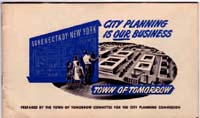
Fig 4.04 [enlarge]
Primer for educating the public on the Town of Tomorrow plan for Schenectady and for encouraging them to get behind the effort.
Before the plan was even completed, supporters realized, like the men of Chicago in 1909, that to "cast it unheralded and unsupported upon a disinterested city would be to condemn it to early oblivion." (7) In 1947, as the Schenectady Town of Tomorrow Committee began to craft a new vision that would include recommendations from Bartholomew's Plan, they were determined to avoid mistakes of the past. Despite the fact that the 1924 Plan "was prepared by far-seeing leaders," it was never completely carried out because not everyone knew about it, and therefore it sat "gathering dust on the shelf for 20 years." (8) To bring the plan to the citizens, the Town of Tomorrow [TOT] was promoted through "essays, speeches and poster contests in the schools, letters and slogan contests, editorials, lectures, radio forums, store window displays, booklets and the like." (9) By early 1948, over 130 talks had been given by TOT speakers to more than 10,000 people. (10)
Even before many residents had an opportunity to consider the specifics of the plan, they were inundated by lofty proclamations touting all the great things that the plan was going to do for them and the city. Moreover they were encouraged to talk up the plan with their families, friends, and neighbors. The following is a brief sampling of what was being said about the plan:
- It will give the city 'a home town which will be the envy of thousands of other communities and the pride of every Schenectadian.'
- It will give young people 'a vision and a goal to which they can dedicate their enthusiasm for years to come.'
- Schenectady could become 'the metropolis of the Mohawk Valley, the distribution center for upstate New York and the transportation hub of the northeastern states.' (11)
- "This marks the beginning of one of the most significant and important periods in the history of our city."
- "This, without a doubt is the most forward looking plan for overall betterment that has ever been conceived in our city. It is up to every Schenectadian to insure its realization." (12)
- Headline: TOT Plan Means Less Taxes, Richer City, Meeting Told
- "…we will show the whole country what a town can do when its people put their backs to the wheel month in and month out…" (13)
The Town of Tomorrow, as part of its 10-Year Plan for Civic Rehabilitation, devised two five-year plans that were divided into either Civic or Commercial and Industrial projects. Proposals that related more directly to the downtown included: housing projects (at least 2,500 units but mostly outside the downtown); slum clearance in the 22 Block area around city hall; widening of downtown streets; a new civic auditorium; a new central high school; improved transit facilities; a face lifting of State Street; a modern central bus terminal; and a new Schenectady Museum. (14) But it was slum-clearance around city hall, made possible through urban renewal, that would capture most of the planning resources of the city for years to come.
Making Way for a New Vision
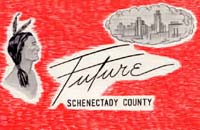
Fig 4.05 [enlarge]
A futuristic vision for the County of Schenectady from the Mohawk Indian's perspective.
The Federal Urban Renewal program, which was created through Title I of the 1949 Housing Act [free PDF viewer required], provided cities with the tools and about two-thirds of the money to deal with substandard conditions. The primary objectives of the program were to:
- Eliminate substandard and other inadequate housing though clearance of slums and blighted areas.
- Stimulate housing production and community development sufficient to remedy the housing shortage.
- Realize the goal of a decent home and a suitable living environment for every American family. (15)
Although these objectives and the fact that it was part of the Federal Housing Administration would imply that housing was the primary focus, the provisions of Title I, as one author explains "were ambiguous enough to accommodate the dreams of its varied supporters." Despite the fact that the "federal government would subsidize only the redevelopment of areas that were primarily residential before clearance or would become primarily residential after reconstruction" the actual wording provided a number of loopholes which allowed cities and developers to destroy residential neighborhoods and replace them with commercial areas. (16) But in many cases it was actually the federal government that killed plans that had any residential component to them. In one of Schenectady's major urban renewal projects, which entailed removing an entire neighborhood around city hall, the Federal Housing Administration said "it would not approve the project if housing was included." (17)
The area around the City Hall, referred to as the "22 Block Area" because it encompassed around 22 acres, was described in the 1948 Plan as "the largest single area requiring redevelopment in the city." This plan showed a graphic of the area redeveloped with new three-story, row apartment buildings, new parking lots, room for future commercial and garden apartment expansion, and a streetscape similar to that proposed in the recent 1999 Downtown Schenectady Design Guidelines. Before the start of the state or federal urban renewal projects the area was largely residential and consisted of buildings dating from the 1870s to early 1900s. While a number of them were considered to be substandard or deteriorated, many of them were well cared for and not in need of any substantial repair before project plans had been announced. But in many people's view, slums should be removed before they affected the land values of the surrounding areas. Typical of the rhetoric of the day is this excerpt from a radio address by Mayor Hubert H. Humprey of Minneapolis in 1948:
Slums, rotten, broken down areas, are the ulcers which may develop into the cancer that will consume the physical and economic structure of the industrial city. Slum areas are extravagances that eat up our revenues and destroy our strength. Either we lick the slums or the slums will destroy the city. (18)
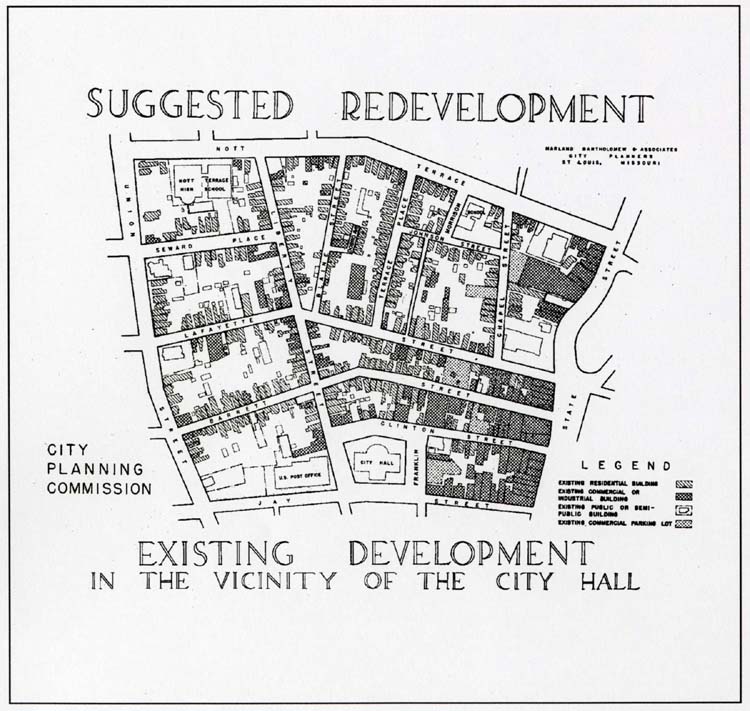
Fig 4.07 [enlarge]
Proposed area for redevelopment and renewal. From the 1948 Comprehensive Plan for Schenectady — later to become known as the 22 Block area.
Planned Blight
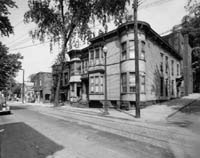
Fig 4.08 [enlarge]
Typical street and conditions in the 22 Block redevelopment area, although not typical of the publicized scene.
A number of critics of urban renewal have described a phenomenon often referred to as planning or planners' blight. Once a project area has been slated for renewal or some other "improvement" that implies displacing the residents or businesses, a natural process of disinvestment begins. The time span between the announcement of the project or even just the rumors about it, and when the residents are forced to leave can often be substantial. "As soon as an area is selected for redevelopment, trouble begins for the residents. If their homes need repair, they hesitate to spend the money without knowing whether they will be compensated; if a rented flat becomes vacant, the owner may have to accept undesirable tenants or none at all because the stable tenant is looking for a place he'll be able to occupy for a while." (19) During this time, the neighborhood becomes unstable, and property assessments and conditions generally decline rapidly. Barrie Needham in How Cities Work: An Introduction refers to this as "Planning Blight" and points out that this downward cycle in property values can sometimes help planners by making acquisition less expensive. (20) It can benefit planners and politicians because by the time they actually begin to raze a formerly viable neighborhood, it may have deteriorated to the point that the public outcry is muted and most people are glad to see it go. In the federal portion of the urban renewal area in Schenectady, a span of over 10 years had elapsed from the time the project was first reported until the first structures were being razed. Adding to that, residents complained that the city had "lowered the assessed valuation" of their properties "to make way for cheap purchase…" (21) before the plan had even been announced.
While cities like Schenectady were concerned with substandard conditions and the well-being of the people who lived in these areas, they were also concerned with low tax rates caused by deteriorated conditions, or land which was not being used most efficiently. Although the two terms are often used interchangeably, throughout the 1950s and 60s, cities were waging a battle against blight and were largely ignoring slums. Robert Beauregard in Voices of Decline: The Postwar Fate of U.S. Cities makes the distinction between blight and slums and explains that it is largely a function of where they are in a city. "Blight was confined to central business districts and slums to neighborhoods." (22)
Blight carried with it a higher potential tax assessment, and therefore was more attractive to deal with. Since cities had to pay for up to one-third of the cost of land clearing, they were more inclined to initiate projects where their return was greater. This included both the return on investment from the initial resale, and the long term property tax increase. In Schenectady, the local paper expressed a similar view, explaining that "the area chosen for redevelopment may not contain the worst slum buildings because consideration must be given to a location that will allow accompanying benefits from street widening and construction of substantial business, rather than residential buildings." (23) Typically those residential building that were removed were not replaced. By June 1971, of the more than 500,000 housing units razed, just over 200,000 had been replaced. (24) This only compounded the problem of affordable housing for many, and severely limited their choice when it came to location.
For those who lived in the targeted urban renewal area in Schenectady, the options were few. Most residents who lived in conditions that were less than perfect could not afford to settle anywhere else. "Finding homes for the families will not be an easy task, as many of them have several families," a news article explained. "One family included eleven children and the father pays a monthly rent of $20 on their home." The project manager, however, did explain that he "would exert every effort to see that these families are relocated in decent, safe and sanitary dwellings within their financial reach." (25)
Limited Options
Despite the hundreds of civic-minded organizations involved in promoting the plan, it was not considered a participatory planning process by any stretch of the imagination. Overall, the residents of the area were strongly opposed to the plan and had not been swayed by the Town of Tomorrow marketing. "We're not interested in the Town of Tomorrow — we're interested in our 22-block area. Our homes are in it. Our livelihood is in it." (26) When they were finally given a forum to voice their opinions, it was a meaningless gesture. The decisions that involved their livelihood had already been finalized and were not about to be reversed. As one councilman noted, "You can't stop progress. They are in an area scheduled for improvements to make Schenectady greater and better." (27)
Decisions about clearing the land had also been made well before the city had a detailed plan of how it should be redeveloped. A number of ideas and a rationale for the plan were suggested. Often, however, they seemed to contradict any common sense or logic. Initially, the plan was portrayed as a way to help the downtown and the existing businesses. By adding more businesses and parking the city felt it could assist the merchants in the rest of downtown. By adding an additional parallel business street, it would relieve some of the congestion of the central business district. But Councilman Samuel S. Stratton had reservations about the city spending so much money to expand the business district when the economic situation had changed for the worse. "I wonder if the merchants feel their problem is not having enough stores to take some of the business they're not getting away from them," he said. Further he implored the city to first get firm commitments from merchants who want to located there, explaining that given the poor economy, they might not be interested when the project is completed. But as another councilman observed, "There is evidence enough to indicate it will be a big success" adding, "Stratton is about the only person in the city against it." (28)
A New Downtown Center
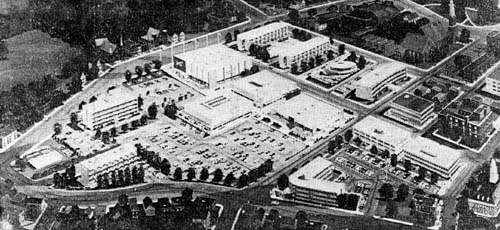
Fig 4.09 [enlarge]
The grand vision of the Lewis Empire Plaza development scheme that never happened. It was to contain a much broader mix and intensity of buildings than was ever realized.
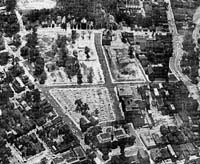
Fig 4.10 [enlarge]
For years the 22 Block area was "shovel ready" for development — waiting for someone with a wide vision and deep pockets.
As the idea for the land shifted over time towards the creation of a large-scale suburban shopping plaza rather than a mix of buildings, merchants began to worry about its impact on their businesses. The massive shopping center with its large parking area would have an unfair advantage, especially since the property taxes paid by the merchants would partially subsidize the project. An attorney for the merchants told the Citizens Participating Committee on Urban Redevelopment that the a big shopping center would have "grave effects" on the existing downtown businesses and would essentially create three separate sections in the downtown. The urban redevelopment project, he argued, should remain in the "realm of public use and public improvement" if it is to benefit all of the downtown. (29) Planners from time to time reminded the merchants that the parking created for a big shopping plaza would be available to their customers as well.
After years of planning and intense efforts to assemble and clear large tracts of land, only one developer stepped forward to develop the 22 Block area. He promised to put $10 milllion into the development. This news was greeted as the "greatest thing ever to hit Schenectady." The headline of the Schenectady Gazette on New Years' Day read: "1959 May See Dream Become Reality in Urban Renewal Area." An accompanying graphic featured an aerial rendering of the proposed project site with restaurants, office buildings, retail stores, motels and hotels, apartments, and a department store. Prior to this, only one other building had been constructed in the redevelopment area.
In March of 1963, the city repossessed the land from Lewis-Empire Plaza, Inc., the company that a few years before had been touted as the "greatest thing ever to hit Schenectady." After four years of little activity, the company had defaulted on its taxes. Construction on one hotel had begun, but as one council member noted there had been almost no activity until just before election day, and then the equipment and crews would move in. Soon after election day, activity on the site would cease. Predictably, the following year activity would resume during election season. "Remember our Republican Mayor sitting on the famous bulldozer four years ago (in the urban redevelopment area)?" Democratic candidate for Mayor Dr. Fred Isabella reminded a crowd in 1963. Continuing he asked, "Where is the taxable building they were boasting about?" (30) For Schenectady, "Just about everything that could go wrong with an urban renewal project did." (31) And even before, while they had been going wrong or going nowhere, the city broke ground on other urban renewal projects. In commenting on the council's approval for the planning commission to begin more renewal projects in 1957, Mayor Stratton said, "After two years and the expenditure of hundreds of thousands of dollars, nobody has any idea how this vacant land is going to be used. The crying need today is to see the present project through successfully, not begin tearing down any more real estate." (32)
Today's Reality
More than twenty years after the Town of Tomorrow was first envisioned, Schenectady was just closing in on the completion of one its major capstone projects, the 22 Block urban renewal site near city hall. A Holiday Inn was finally built, a few office buildings were constructed, a Firestone Auto Service Center opened, and the Two Guys department store opened with a separate hardware store across the street. The department store and hardware store lasted less than twenty years. The department store was eventually converted into offices. The hardware store became a car dealership, then a managed health care facility, and is now empty. The Firestone Center closed a few years ago and the building remains vacant. The Holiday Inn continues to do well, and the office buildings, despite occasional vacancies, have been successful. But overall, the site appears underdeveloped, with large parking lots occupying important intersections, a few nondescript buildings, minimal landscaping, and almost no pedestrian activity or street life. Despite the futuristic visions, lofty proclamations, and millions in taxpayer dollars spent, the Town of Tomorrow was a thing of the past before its time ever came.
